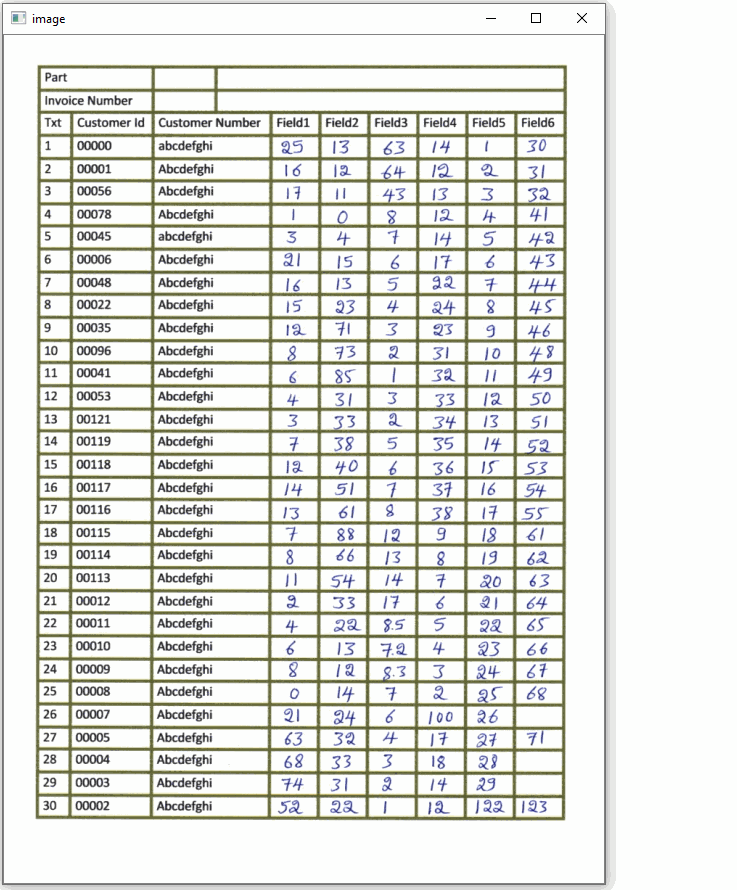Extract individual field from table image to excel with OCR
You're on the right track. Here's a continuation of your approach with slight modifications. The idea is:
Obtain binary image. Load image, convert to grayscale, and Otsu's threshold.
Remove all character text contours. We create a rectangular kernel and perform opening to only keep the horizontal/vertical lines. This will effectively make the text into tiny noise so we find contours and filter using contour area to remove them.
Repair horizontal/vertical lines and extract each ROI. We morph close to fix and broken lines and smooth the table. From here we sort the box field contours using
imutils.sort_contours()with thetop-to-bottomparameter. Next we find contours and filter using contour area then extract each ROI.
Here's a visualization of each box field and the extracted ROI

Code
import cv2
import numpy as np
from imutils import contours
# Load image, grayscale, Otsu's threshold
image = cv2.imread('1.jpg')
original = image.copy()
gray = cv2.cvtColor(image, cv2.COLOR_BGR2GRAY)
thresh = cv2.threshold(gray, 0, 255, cv2.THRESH_BINARY_INV + cv2.THRESH_OTSU)[1]
# Remove text characters with morph open and contour filtering
kernel = cv2.getStructuringElement(cv2.MORPH_RECT, (3,3))
opening = cv2.morphologyEx(thresh, cv2.MORPH_OPEN, kernel, iterations=1)
cnts = cv2.findContours(opening, cv2.RETR_TREE, cv2.CHAIN_APPROX_SIMPLE)
cnts = cnts[0] if len(cnts) == 2 else cnts[1]
for c in cnts:
area = cv2.contourArea(c)
if area < 500:
cv2.drawContours(opening, [c], -1, (0,0,0), -1)
# Repair table lines, sort contours, and extract ROI
close = 255 - cv2.morphologyEx(opening, cv2.MORPH_CLOSE, kernel, iterations=1)
cnts = cv2.findContours(close, cv2.RETR_TREE, cv2.CHAIN_APPROX_SIMPLE)
cnts = cnts[0] if len(cnts) == 2 else cnts[1]
(cnts, _) = contours.sort_contours(cnts, method="top-to-bottom")
for c in cnts:
area = cv2.contourArea(c)
if area < 25000:
x,y,w,h = cv2.boundingRect(c)
cv2.rectangle(image, (x, y), (x + w, y + h), (36,255,12), -1)
ROI = original[y:y+h, x:x+w]
# Visualization
cv2.imshow('image', image)
cv2.imshow('ROI', ROI)
cv2.waitKey(20)
cv2.imshow('opening', opening)
cv2.imshow('close', close)
cv2.imshow('image', image)
cv2.waitKey()
nanthancy's answer is also accurate, I used the following script for getting each box and sorting it by columns and rows.
Note: Most of this code is from a medium blog by Kanan Vyas here: https://medium.com/coinmonks/a-box-detection-algorithm-for-any-image-containing-boxes-756c15d7ed26
#most of this code is take from blog by Kanan Vyas here:
#https://medium.com/coinmonks/a-box-detection-algorithm-for-any-image-containing-boxes-756c15d7ed26
import cv2
import numpy as np
img = cv2.imread('images/scan2.jpg',0)
#fn to show np images with cv2 and close on any key press
def imshow(img, label='default'):
cv2.imshow(label, img)
cv2.waitKey(0)
cv2.destroyAllWindows()
# Thresholding the image
(thresh, img_bin) = cv2.threshold(img, 250, 255,cv2.THRESH_BINARY|cv2.THRESH_OTSU)
#inverting the image
img_bin = 255-img_bin
# Defining a kernel length
kernel_length = np.array(img).shape[1]//80
# A verticle kernel of (1 X kernel_length), which will detect all the verticle lines from the image.
verticle_kernel = cv2.getStructuringElement(cv2.MORPH_RECT, (1, kernel_length))# A horizontal kernel of (kernel_length X 1), which will help to detect all the horizontal line from the image.
hori_kernel = cv2.getStructuringElement(cv2.MORPH_RECT, (kernel_length, 1))# A kernel of (3 X 3) ones.
kernel = cv2.getStructuringElement(cv2.MORPH_RECT, (3, 3))
# Morphological operation to detect vertical lines from an image
img_temp1 = cv2.erode(img_bin, verticle_kernel, iterations=3)
verticle_lines_img = cv2.dilate(img_temp1, verticle_kernel, iterations=3)
#cv2.imwrite("verticle_lines.jpg",verticle_lines_img)
# Morphological operation to detect horizontal lines from an image
img_temp2 = cv2.erode(img_bin, hori_kernel, iterations=3)
horizontal_lines_img = cv2.dilate(img_temp2, hori_kernel, iterations=3)
#cv2.imwrite("horizontal_lines.jpg",horizontal_lines_img)
# Weighting parameters, this will decide the quantity of an image to be added to make a new image.
alpha = 0.5
beta = 1.0 - alpha# This function helps to add two image with specific weight parameter to get a third image as summation of two image.
img_final_bin = cv2.addWeighted(verticle_lines_img, alpha, horizontal_lines_img, beta, 0.0)
img_final_bin = cv2.erode(~img_final_bin, kernel, iterations=2)
(thresh, img_final_bin) = cv2.threshold(img_final_bin, 128,255, cv2.THRESH_BINARY | cv2.THRESH_OTSU)
cv2.imwrite("img_final_bin.jpg",img_final_bin)
# Find contours for image, which will detect all the boxes
contours, hierarchy = cv2.findContours(img_final_bin, cv2.RETR_TREE, cv2.CHAIN_APPROX_SIMPLE)
""" this section saves each extracted box as a seperate image.
idx = 0
for c in contours:
# Returns the location and width,height for every contour
x, y, w, h = cv2.boundingRect(c)
#only selecting boxes within certain width height range
if (w > 10 and h > 15 and h < 50):
idx += 1
new_img = img[y:y+h, x:x+w]
#cv2.imwrite("kanan/1/"+ "{}-{}-{}-{}".format(x, y, w, h) + '.jpg', new_img)
"""
#get set of all y-coordinates to sort boxes row wise
def getsety(boxes):
ally = []
for b in boxes:
ally.append(b[1])
ally = set(ally)
ally = sorted(ally)
return ally
#sort boxes by y in certain range, because if image is tilted than same row boxes
#could have different Ys but within certain range
def sort_boxes(boxes, y, row_column):
l = []
for b in boxes:
if (b[2] > 10 and b[3] > 15 and b[3] < 50):
if b[1] >= y - 7 and b[1] <= y + 7:
l.append(b)
if l in row_column:
return row_column
else:
row_column.append(l)
return row_column
#sort each row using X of each box to sort it column wise
def sortrows(rc):
new_rc = []
for row in rc:
r_new = sorted(row, key = lambda cell: cell[0])
new_rc.append(r_new)
return new_rc
row_column = []
for i in getsety(boundingBoxes):
row_column = sort_boxes(boundingBoxes, i, row_column)
row_column = [i for i in row_column if i != []]
#final np array with sorted boxes from top left to bottom right
row_column = sortrows(row_column)
I made this in Jupyter notebook and copy-pasted here, if any errors come up, let me know.
Thank you everyone for answers